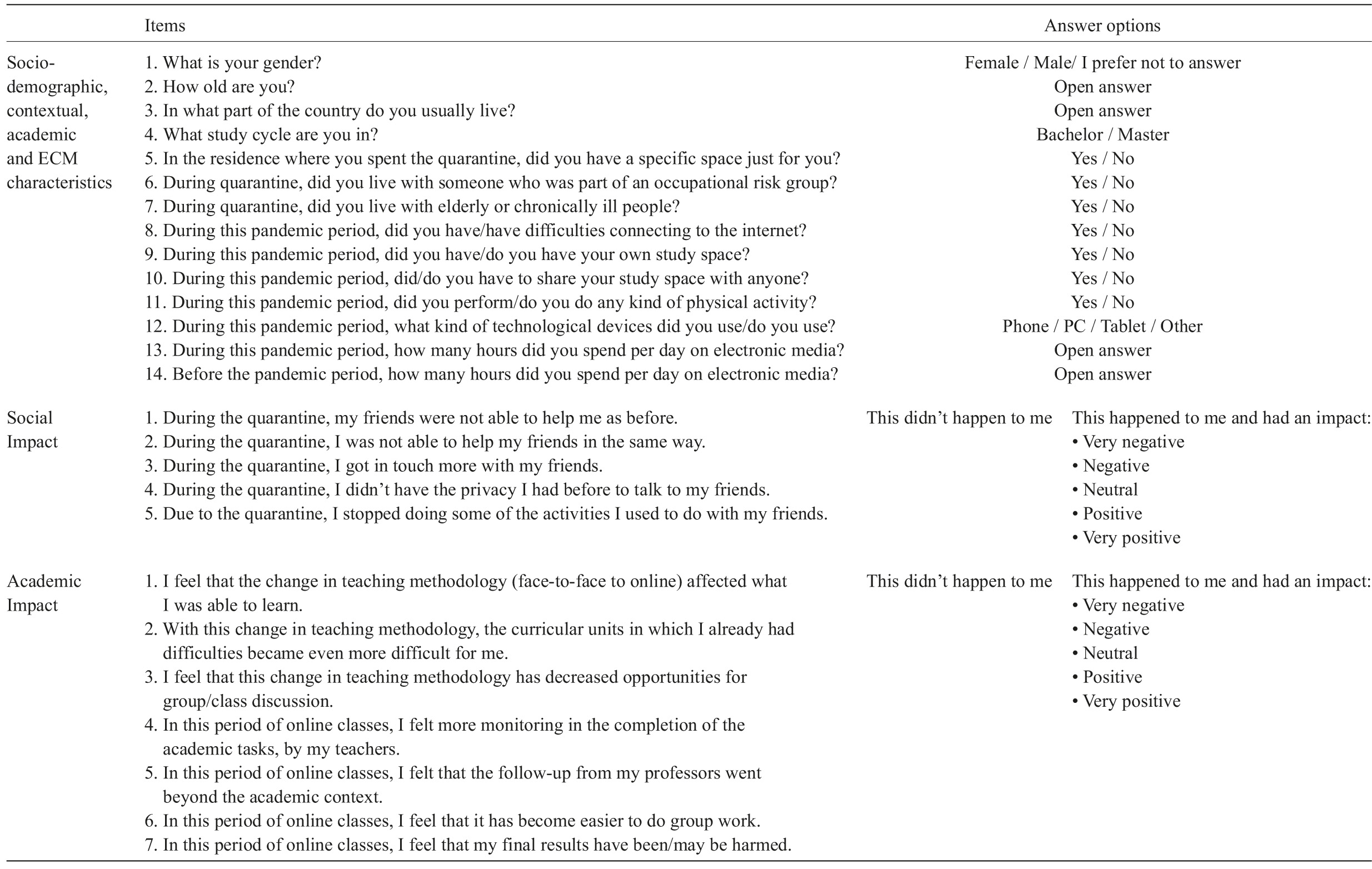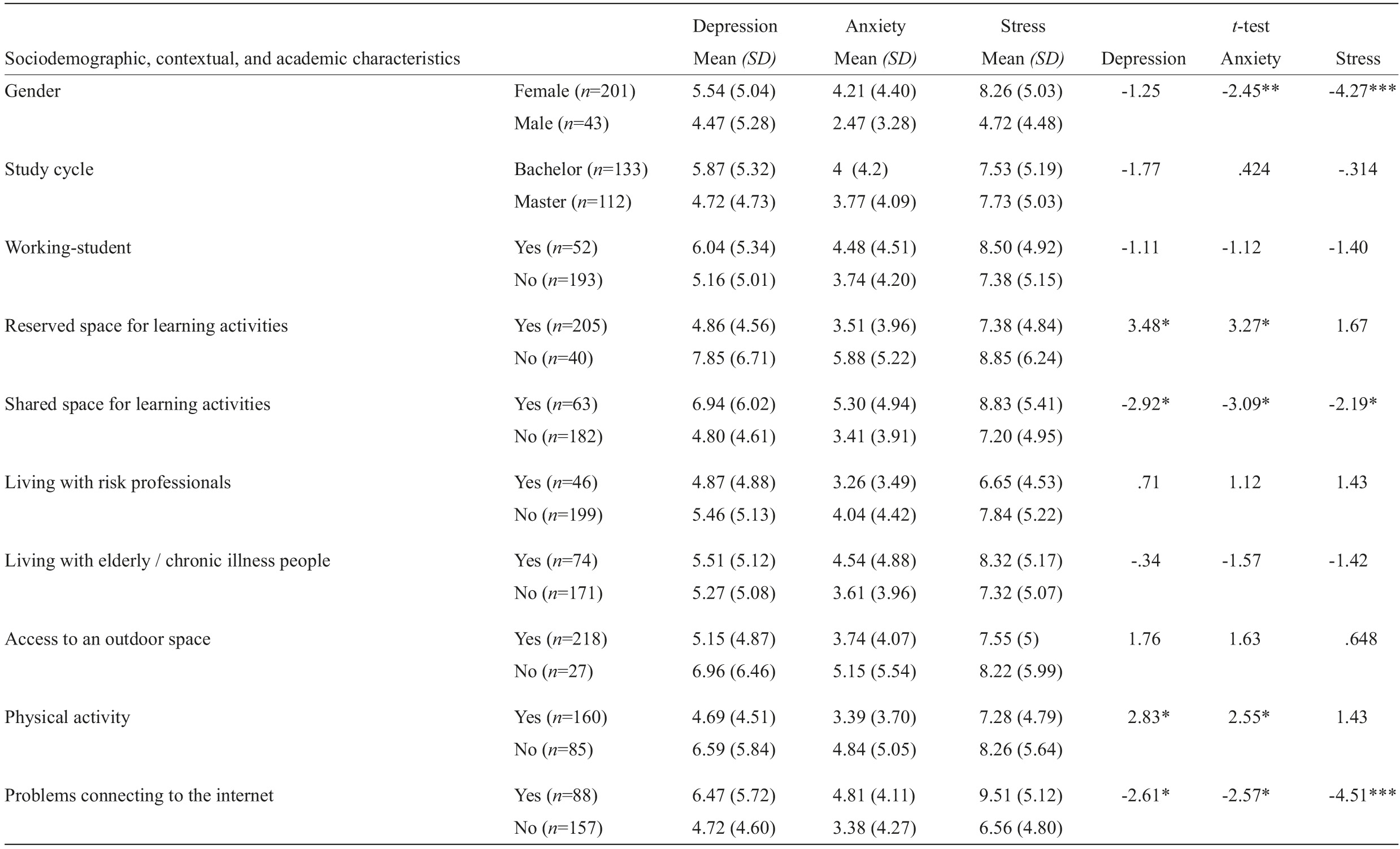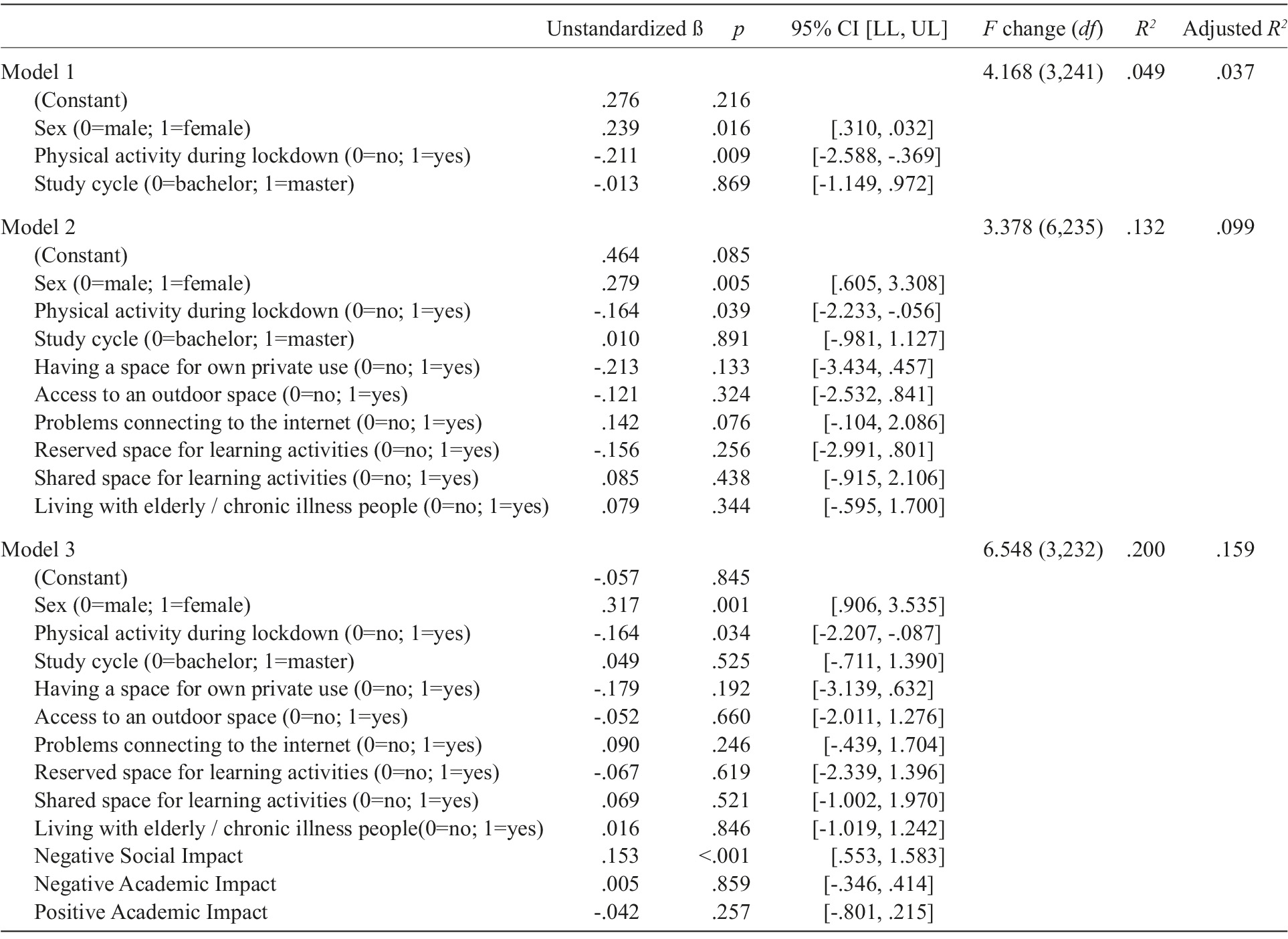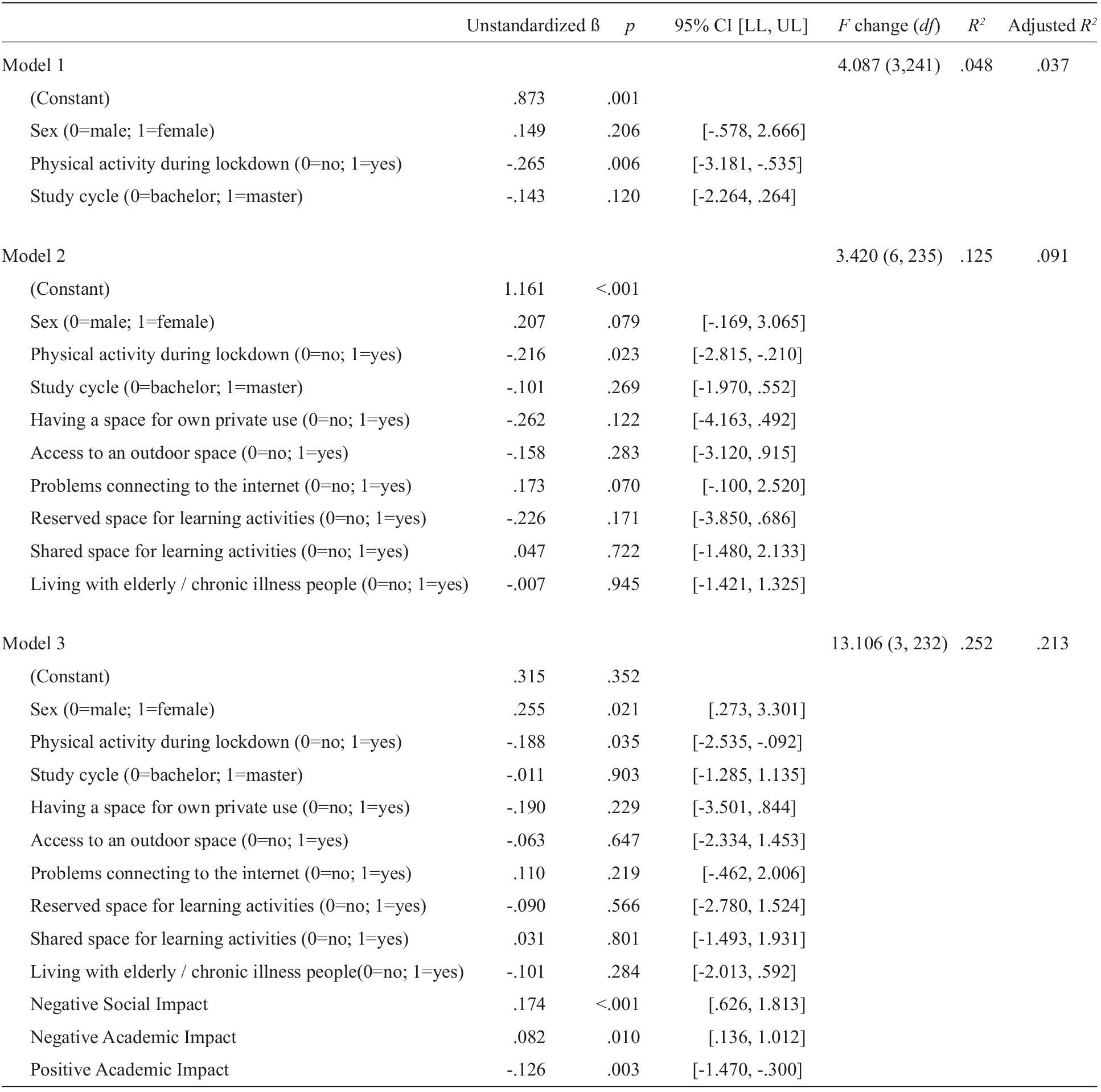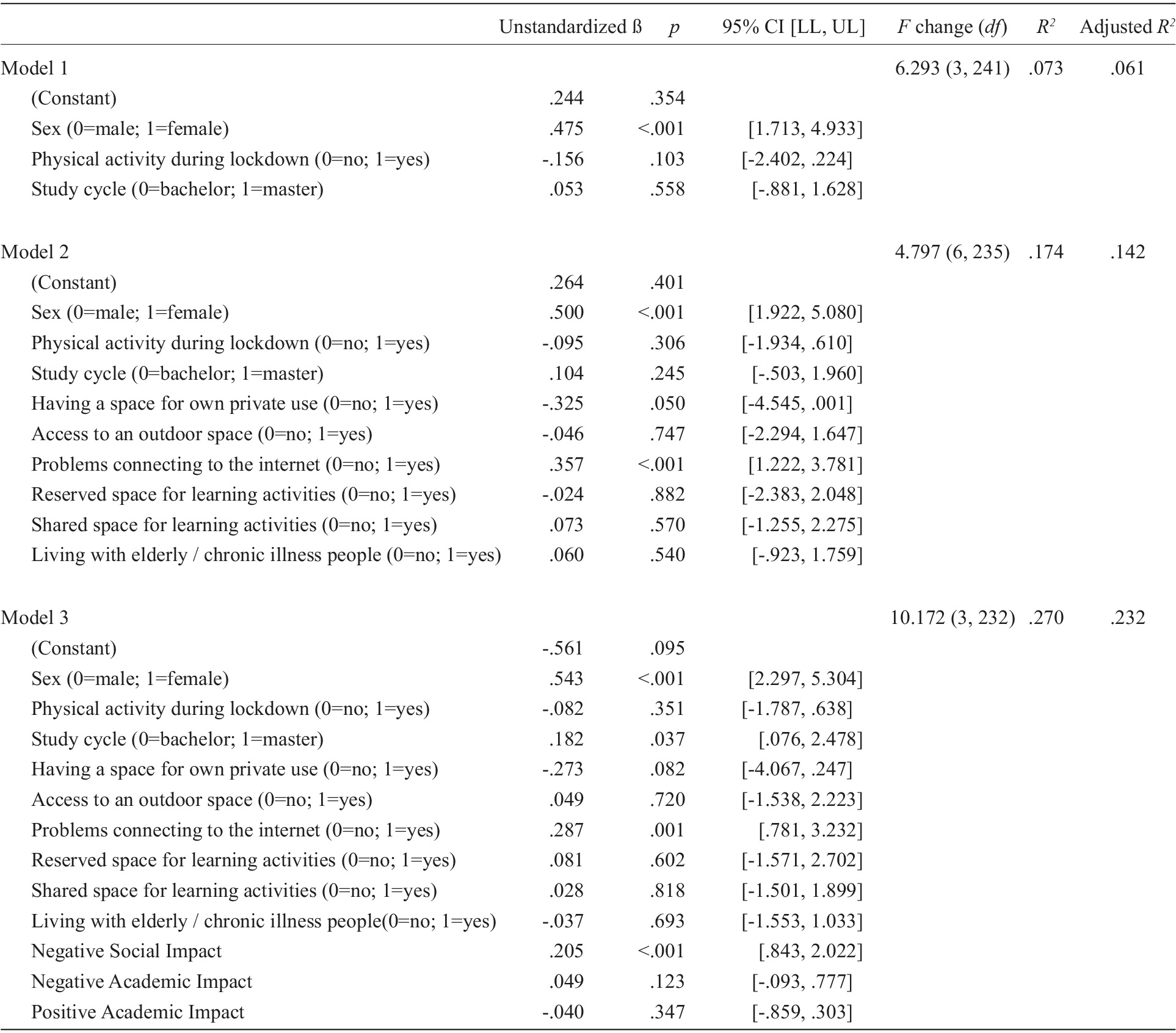Introduction
Higher education challenges young people in different domains (Barbosa et al., 2020; Guedes et al., 2019; Leal et al., 2019; Moutinho et al., 2019; Rodrigues et al., 2020; Toti et al., 2018), among which the transformations in friendship networks and social support; the new methodologies and learning rhythms; the highest levels of demand in academic curricula; expectations regarding the future and professional career; greater responsibility and autonomy in time management and definition of study goals and strategies; and changes in the psychosocial context (e.g., leaving the parents’ home). These challenges increase their risk of developing mental health problems (Chan & Sun, 2020; Harrer et al., 2019). A meta-analysis that included 48 studies and a total of 10,583 participants (between 18 and 29 years) reports a significant prevalence of depression (the most frequent disorder in 26 studies), anxiety (the most frequent disorder in 24 studies) and stress (the most frequent disorder in 16 studies) among university students (Harrer et al., 2019).
Literature has identified protective factors for the adaptation to higher education, among which social support and the pedagogical relationship. Social support has been associated with higher levels of adaptation in university students due to the sense of belonging it provides (Moutinho et al., 2019; Soares et al., 2019; Soares, Leme et al., 2018; Soares, Porto et al., 2018) while a positive pedagogical relationship is a crucial factor for the teaching and learning process (Silva & Ribeiro, 2020; Yates et al., 2021).
The COVID-19 pandemic has led to a sudden change in higher education, and college students - previously identified as a risk group for mental health problems (Chan & Sun, 2020; Harrer et al., 2019; Husky et al., 2020) - were one of the most affected groups (Brooks et al., 2020; Li et al., 2020; Quintiliani et al., 2021; Sequeira et al., 2022; Stevanovic et al., 2021). In addition to the transition from face-to-face to online teaching, this population was faced with significant changes in their academic routines. The scientific community quickly focused its attention on this phenomenon, seeking to explore the experience of university students during the pandemic. Among the various studies (e.g., Aristovnik et al., 2020; Branquinho et al., 2020; Chaudhary et al., 2021; Chen & Lucock, 2022; George & Thomas, 2020) similar results were found, highlighting concerns about academic performance and the professional future of students; the quality of online teaching; the loss of formal and informal support provided by higher education institutions; the loss of pleasant routines and activities; remote contact with the support network; difficulties in concentration and motivation for learning; the quality of the internet connection; lack of adequate digital skills; the suspension of academic traditions and milestones; the loss of economic status; and physical and psychological well-being during the pandemic.
Castells (2021) underlines the importance of electronic media (ECM) in the adaptation to social and academic contexts affected by the pandemic, highlighting the learning activities that inevitably became mediated by technology. In Portugal, the proportion of users who communicated with teachers or colleagues through online educational portals increased from 14.5% in 2019 to 30.8% in 2020; the percentage of students who attended online courses increased from 7.7% in 2019 to 18.0% in 2020 (Statistics Portugal, 2020). ECM allowed students’ progress through the 2019-2020 academic year (Có et al., 2020; Ferreira et al., 2020), and the proximity of university students to their support networks, becoming an alternative path in the face of the physical distance imposed by the pandemic (Có et al., 2020; Cruz, 2020; Duvenage et al., 2020; Straker et al., 2018).
The present study aimed to examine the social, academic, and psychological functioning (anxiety, depression, and stress), during the first lockdown due to COVID-19, of a group of Portuguese college students. Specifically, the study aimed to: (a) characterize the perception of the social, academic, and psychological impact of the first COVID-19 lockdown (March-July 2020); (b) examine the relationship between the perception of social, academic, and psychological impact and sociodemographic, contextual, and academic characteristics; (c) to study the sociodemographic, contextual, social, and academic predictors of the psychological impact of the lockdown.
Materials and methods
Participants
The sample included 247 college students (82.2% female), aged between 18 and 30 years [Mean (M)=21.9, Standard Deviation (SD)=2.2].
Contextual characteristics. Most participants (219; 88.7%) had access to outdoor space (e.g., balcony, backyard) and 216 (87.4%) reported having a space for their private use in their homes. Students reported living in houses with one to eight people (M=3.6, SD=1.1). The number of other people attending online courses at the same house ranged from zero to five (M=1.5, SD=0.83). Almost 20% of students (18.6%) reported living with risk-group professionals (e.g., nurses, doctors, and police officers).
Thirty percent of students reported living with elderly people or people with chronic illnesses. A small group of participants (3.2%) mentioned living with someone infected with COVID-19. The number of people working remotely from home ranged from zero to four (M=0.9, SD=0.9). Eighty-nine participants (36.2%) reported having problems connecting to the internet.
Academic characteristics. The study included students from 22 higher education institutions (nine of them public, and 13 private). One hundred and thirty-four students (54.3%) attended bachelor’s programs and 113 (45.7%) master’s programs.
Almost all the students were attending online classes (n=228; 92.3%). Most students (83.4%) reported having a space for their own learning activities; 63 students referred having to share the learning space with another person.
ECM use characteristics. Almost all the students (98%) reported using a computer during the lockdown. The use of smartphones was reported by 240 students (97.2%). Other devices (e.g., tablets) were used by a smaller percentage of students (25.5%).
The daily average number of hours of ECM use, on a typical weekday during the lockdown, was nine hours (SD=4.5), compared with five hours (SD=3.4) before the lockdown.
Measures
A questionnaire (COVID-19: Social and Academic Impact Questionnaire) was specifically developed to assess three dimensions in this study: (1) sociodemographic, academic, and ECM use; (2) social impact; (3) academic impact. Items were generated by the research team, based on brainstorming procedures, considering the experience faced by members of the research team (university graduate students and teaching staff) and their theoretical and empirical background in Psychology. The psychological impact was assessed by the Depression, Anxiety, and Stress Scale (Lovibond & Lovibond, 1995; Pais-Ribeiro et al., 2004).
COVID-19: Social and academic impact questionnaire. The first section of the questionnaire includes questions regarding sociodemographic, contextual, academic, and ECM characteristics. It includes 14 items - three items related to sociodemographic characteristics (e.g., gender); one item related to academic characteristics (study cycle); six items on contextual variables (e.g., problems connecting to the internet; private space for learning activities); and four items regarding ECM use (e.g., use of different ECM devices; average hours of ECM use during and before the lockdown).
The second section includes five items related to the social impact of the lockdown (e.g., “during the lockdown I didn’t have the privacy that I used to have to talk with my friends”).
The third part includes seven items regarding the academic impact of the lockdown (e.g., “I think that the shift from face-to-face to online courses reduced the opportunities to discuss subjects with my peers”).
Table 1 presents all the items of this questionnaire and the response scale used.
Depression, Anxiety and Stress Scales. The Depression, Anxiety and Stress Scales (DASS-21; Lovibond & Lovibond, 1995) include 21 items - with a 4-point Likert response scale - assessing depressive, anxious, and stress symptoms (seven items each). The higher the scores in each dimension, the higher the levels of depression, anxiety, and stress. The Portuguese version of the DASS-21 has demonstrated appropriate construct and convergent/discriminant validity scores, and good reliability values (Cronbach’s α=.85 for depression; α=.74 for anxiety; α=.81 for stress) (Pais-Ribeiro et al., 2004).
Procedures
Data collection procedures. Authorization to perform the study was obtained from the Research Ethics Committee of Universidade Católica Portuguesa (ref. 1008/2020). Data were collected online (using Qualtrics) between March and July 2020, during the first lockdown imposed under the State of Emergency laws (Resolução da Assembleia da República, 2020), which led to important restrictions, most of them impacting young people’s lives: duty to stay at home; suspension of all non-essential activities; closing of nightlife establishments; ban on gatherings on public roads or in domestic spaces; and suspension of all face-to-face academic activities.
Participants were invited to participate in the study through a link shared through the junior researchers’ social media accounts and institutional e-mail of the research team’s HEI. Only participants who stated being university students and who gave their informed consent in the beginning of the online questionnaire proceeded to data collection. Data collection was anonymous.
Data analysis procedures. Descriptive statistics were calculated for all variables. Chi-square tests and independent samples t-tests were used to examine group differences. The analysis of predictors of psychological impact was conducted using hierarchical multiple linear regressions. Each regression tested three models: the first model included participants’ gender and study cycle as independent variables, considering gender differences and possible differences between students starting their higher education trajectories (bachelor’s degree), and students attending more advanced academic trajectories (master’s degree), regarding stress, anxiety, and depressive symptoms. The second model included the sociodemographic and contextual variables as independent variables. The third model added the composite scores of social and academic (positive and negative) perceived by the participants during the first lockdown as independent variables. The negative social impact score consisted of the sum of four items (“During the quarantine, my friends were not able to help me as before”; “During the quarantine, I was not able to help my friends in the same way”; “During the quarantine, I didn’t have the privacy I had before to talk to my friends”; “Due to the quarantine, I stopped doing some of the activities I used to do with my friends”). The negative academic impact score consisted of the sum of four items (“I feel that the change in teaching methodology (face-to-face to online) affected what I was able to learn”; “With this change in teaching methodology, the curricular units in which I already had difficulties became even more difficult for me”; “I feel that this change in teaching methodology has decreased opportunities for group/class discussion”; “In this period of online classes, I feel that my final results have been/may be harmed”). Finally, the positive academic impact score consisted of the sum of three items (“In this period of online classes, I felt more monitoring in the completion of the academic tasks, by my teachers”; “In this period of online classes, I felt that the follow-up from my professors went beyond the academic context”; “In this period of online classes, I feel that it has become easier to do group work”). All independent variables that were dichotomous were treated as dummy variables (0 vs. 1). A posthoc power analysis was conducted using G*Power 3.1, to examine if the sample size was adequate for the regression analyses. Results indicate a power of .99.
All tests were two-tailed with significance levels of p<0.05. Statistical analysis was performed using IBM SPSS Statistics for Windows, Version 28.
Results
Characterization of the perception of social, academic, and psychological impact of the first lockdown due to COVID-19 (March-July 2020)
Social Impact. Most participants reported a negative/very negative impact of the situations presented in the questionnaire. However, most students (92%) stated that the increase of contact with friends had a positive/very positive impact (Tables 2 and 3).
Academic impact. Most participants reported a negative/very negative impact caused by the situations presented in the questionnaire. However, the increase in academic task monitoring, the increase in teachers’ support, and the facility in conducting group tasks had a positive/very positive impact (Tables 4 and 5).
Psychological impact. The levels of depression, anxiety, and stress were classified, from “normal” to “extremely severe”, using cut-off scores suggested by the Black Dog Institute (2021). Moderate to extremely severe scores in depression and stress were shown by around 30% of the sample and around 25% of the participants reported moderate to extremely severe levels of anxiety (Table 6).
Association between social, academic, and psychological impact, and sociodemographic, contextual, and academic characteristics
Regarding the social impact, problems connecting to the internet were associated with the perception of a reduction in social support and with the reduction of privacy. The absence of a private space, at home, was associated with a reduction of social support, a reduction of privacy, and a reduction of activities with friends (Table 7).
Table 7 Association between sociodemographic, contextual, and academic characteristics, and social and academic impact (chi square tests)
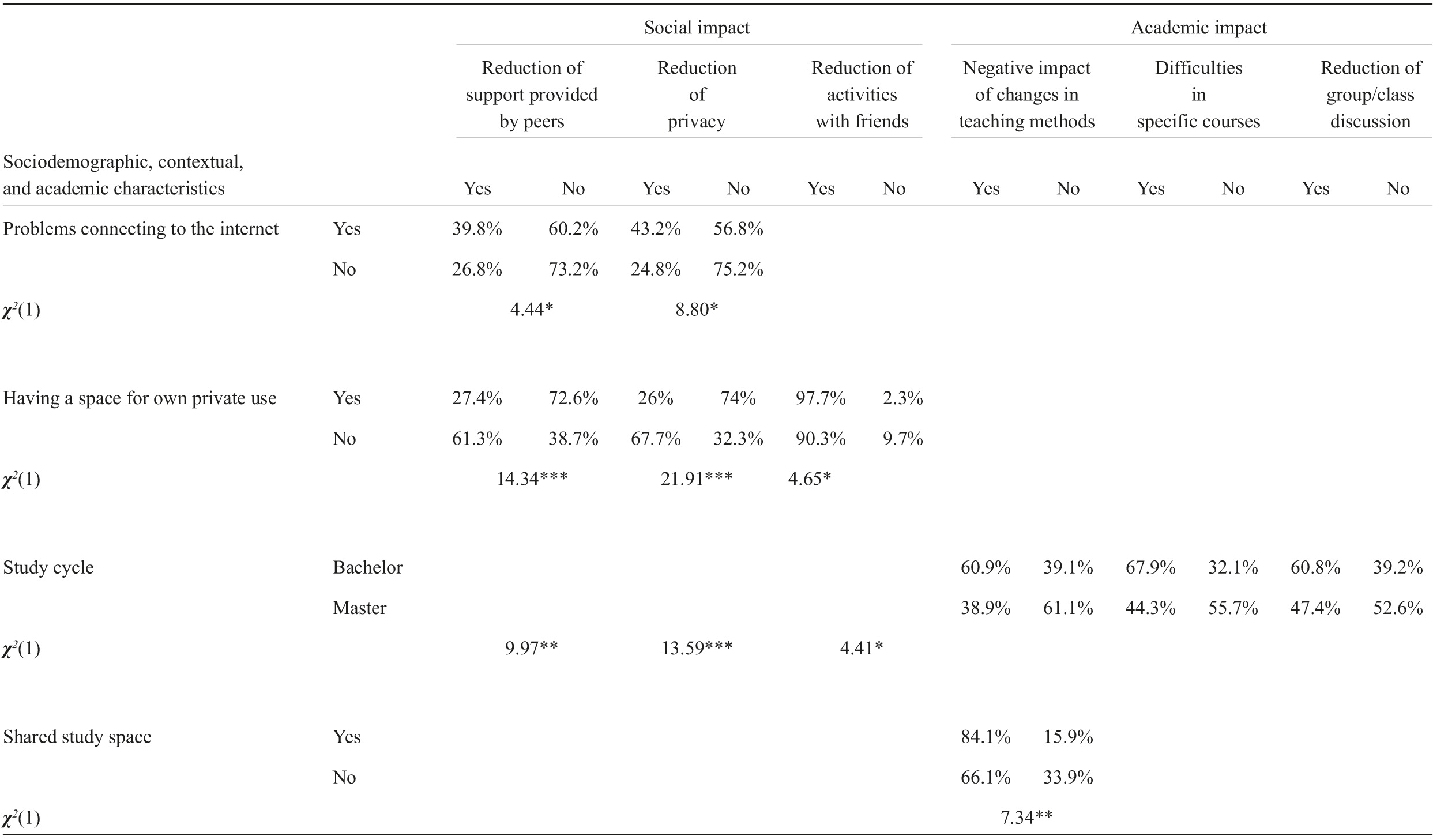
Note. *p<.05; **p<.01; ***p<.001.
Regarding the academic impact, students from bachelor programs reported a more negative impact on learning because of the changes in teaching methods, more difficulties in specific courses, and a larger reduction of group/class discussion, in comparison with master students. The need to share a space for learning activities was associated with a more negative impact on learning because of the changes in teaching methods (Table 7).
Students who reported not having a private space for study activities and who stated not having physical activity during the lockdown reported higher levels of depressive and anxious symptoms. Students who had to share a space for studying and those who reported problems connecting to the internet showed higher levels of depression, anxiety, and stress. Furthermore, female students reported higher levels of anxiety and stress, compared to male students (Table 8).
Sociodemographic, contextual, and academic predictors of social, academic, and psychological impact
Regarding the predictors of anxiety symptoms, the multicollinearity assumption is verified - all VID<1.96. The regression model is significant, F(12,244)=4.83, p<.001, R 2 aj=.16. Being female, not having physical activity during the lockdown, and perceiving a more negative social impact predict higher levels of anxiety (b=0.32, SE=0.10, B=.20, t=3.33, p=.001; b=-0.16, SE=0.08, B=-.13, t=-2.13, p=.03; b=0.15, EP=0.04, B=.27, t=4.09, p<.001, respectively). The remaining predictors were not significant, all b<.18, all p>.19 (Table 9).
Concerning the predictors of depressive symptoms, the multicollinearity assumption is verified - all VID<1.96. The regression model is significant, F(12,244)=6.50, p<.001, R 2 aj=.21. Being female, not practicing physical activity during lockdown, perceiving higher levels of negative social and academic impact, and perceiving lower levels of positive academic impact predict higher levels of depressive symptoms (b=0.26, SE=0.11, B=.14, t=2.33, p=.02; b=-0.19, SE=0.09, B=-.12, t=-2.12, p=.04; b=0.17, SE=0.04, B=.26, t=4.05, p<.001; b=0.08, SE=0.03, B=.16, t=2.59, p=.01; b=-0.13, SE=0.04, B=-.18, t=-2.10, p=.003, respectively). The remaining predictors were not significant, all b<.19, all p>.22 (Table 10).
Regarding the predictors of stress, the multicollinearity assumption is verified - all VID<1.96. The regression model is significant, F(12,244)=7.15, p<.001, R 2 aj=.27. Being female, attending a bachelor’s degree, having difficulties connecting with the internet, and perceiving higher levels of negative social support predicted higher levels of stress (b=0.54, SE=0.11, B=.29, t=4.10, p<.001; b=0.18, SE=0.09, B=.13, t=2.09, p=.04; b=0.29, SE=0.09, B=.19, t=3.22, p=.001; b=0.20, SE=0.04, B=.30, t=4.80, p<.001, respectively). The remaining predictors were not significant, all b<.29, all p>.08 (Table 11).
In the three regression analyses, adding the contextual variables and perceived social and academic impact variables to the sociodemographic variables resulted in an increased explained variance.
Discussion
Higher education students were one of the social groups most affected by the COVID-19 pandemic (Rapanta et al., 2020; Shah et al., 2020; Sun et al., 2020; Sundarasen et al., 2020; YoungMinds, 2021). The negative social, academic, and psychological impact on a high percentage of the surveyed students from the present study reinforces this idea.
Social impact
The results showed a negative/very negative social impact of the reduction of received and provided support to peers, privacy, and activities with friends. The absence of face-to-face contact and the restriction of activities to a single context (home), together with difficulties connecting to the internet, may have led to a reduction in privacy, social support, and activities, as shown in other studies with university students during the pandemic (e.g., YoungMinds, 2021). On the other hand, when increased contact with the support network occurred, a positive/very positive impact was reported by young people, reinforcing the protective role of the social support network in crisis contexts. This increased online contact was only possible through ECM use (Castells, 2021).
Academic impact
Young people reported a negative/very negative impact of changes in the teaching methods on their learning process, increasing difficulties in specific courses, reduction of group/class discussions, and anticipation of negative final grades. The transition from face-to-face to online teaching may have contributed to the reduction of group/class discussions [fundamental for learning (Sahu, 2020)], which may explain the increase in difficulties in specific courses and the negative impact on final grades reported by young people (Gallego-Gómez et al., 2020).
The undergraduate students perceived a more negative impact of the change in the teaching methods on learning, the increase in difficulties in specific courses, and the reduction of group/class discussions compared to graduate students. The specificities that mark the first study cycle (e.g., the adaptation to a new work rhythm) may help to understand these results, since the adaptation phase in which undergraduate students are may have reinforced the difficulties experienced during the pandemic (Ferreira et al., 2020).
Students who shared their study space also reported a more negative impact of the changes in teaching methods on learning, so the overlap of online classes and teleworking may have contributed to difficulties in monitoring and participating in academic activities (Castells, 2021; YoungMinds, 2020). The lack of a study space or the sharing of this space and the difficulties connecting to the internet may have contributed to the reduction of the academic performance perceived by young people, exposing them to a low sense of competence and/or feelings of insecurity that, together with the concerns about the progression and completion of the school year (Gallego-Gómez et al., 2020) may explain the levels of depression, anxiety and stress experienced by some participants.
On the positive side, participants who reported an increase in the monitoring of academic tasks, more support from teachers, and greater ease in carrying out group work also rated these changes as having a positive/very positive academic impact. The use of ECM [which allows rapid and instantaneous communication (Ferreira et al., 2020)] may help to understand this result. Almost all the participants reported using technological devices (e.g., smartphones or computers), in line with data suggesting that the use of these devices has been widespread during the pandemic (Gallego-Gómez et al., 2020; Stevanovic et al., 2021).
Psychological impact
Prior to the COVID-19 pandemic, university students were already considered a risk group for mental health problems (e.g., Chan & Sun, 2020; Harrer et al., 2019). With the onset of the pandemic, several studies focused on its impact on the psychological well-being of college and university students, pointing to an increased risk for the development of mental health problems in this population (e.g., Li et al., 2020; Quintiliani et al., 2021; Sequeira et al., 2022). The present study reinforces this idea, particularly regarding the levels of anxiety, depression, and stress. As in other studies (e.g., Deng et al., 2021), the levels of depression in university students were more prominent, with 30% of participants presenting moderate to severe levels. Similar results were found concerning stress (30% with moderate to severe levels) and anxiety (25% manifesting moderate to severe levels).
This globally negative psychological impact - with moderate to extremely severe levels of depression, anxiety, and stress - may have been the result of the combination of pre-existing risk factors faced by this population and the perception of negative social and academic impact resulting from the pandemic (Brooks et al., 2020; Li et al., 2020; Quintiliani et al., 2021).
Female participants reported higher levels of anxiety and stress, so the risk factor for the development of pre-pandemic anxiety disorders may have been potentiated by the stressful circumstances that marked the sudden onset of COVID-19. Similarly, the absence of physical activity - a protective factor for pre-pandemic mental health (Cao et al., 2020; Lew et al., 2019; Nabity-Grover et al., 2020; Wang et al., 2020; Zhang et al., 2020) - may have contributed to greater impairment of students’ physical and mental well-being, leading to higher levels of depressive and anxious symptoms.
Being female, not practicing physical activity, having difficulties connecting to the internet, and/or attending an undergraduate degree predicted a negative psychological impact - depression, anxiety, and stress - on students. These results are in line with the literature regarding gender differences in the psychological impact of the pandemic (Silva et al., 2021; Wenham et al., 2020; Xiong et al., 2020). Some personal characteristics, such as greater emotional expression, lower tolerance for uncertainty, and less effective strategies to face the pandemic were more frequently observed in female students (Sundarasen et al., 2020). Reduced physical activity is one of the consequences of the interruption of social activities reported by students during the pandemic (YoungMinds, 2021). Furthermore, as stated above, some contextual factors - difficulties connecting to the internet - contributed to a negative social impact, while being an undergraduate student was related to a more negative academic impact. These results may explain the higher levels of psychological impact reported by students with those characteristics.
Conclusions
The present study was conducted “in the eye of the hurricane” which was the first lockdown imposed by governments at the beginning of the COVID-19 pandemic (March-July 2020). The study’s data allowed us to understand, at that moment, the social, academic, and psychological reality of a group of higher education students in Portugal. The use of an online questionnaire, distributed through social media, may have resulted in a non-balanced distribution of higher education institutions (considering the country’s regional representativeness), as well as the number of undergraduate vs graduate students, and a biased sample regarding access to the internet. Furthermore, the assessment of the perceived social and academic impact of the lockdown was made using a questionnaire, specifically developed for this study, that was not previously validated, due to the constraints imposed by the unique situation we were living in. These limitations should be considered when interpreting results. Another limitation was the absence of an explicit statement, on the online form, sharing information regarding psychosocial support services for those participants who were feeling psychologically vulnerable.
Knowing university students’ social, academic, and psychological reality during the pandemic led to a greater awareness of protective factors related to teaching-learning and psychological adaptation to higher education. Results from the present study highlight the role of contextual variables in the social, academic, and psychological impact of a lockdown during a unique moment in contemporary life. These variables probably reflect preexisting differences in social, economic, and cultural conditions of HEI students, increasing the gap in academic inequalities. Therefore, this issue should be addressed continuously as it may continue to have a significant impact after the pandemic, particularly for students with lower means.
The results of this study reinforce the importance of monitoring and support practices by teachers, highlighting their positive effect on students’ motivation and involvement in learning. The social, academic, and psychological impact of the pandemic on students who are still, in 2023, enrolled in higher education should be addressed by the institutions. This group of students may present a critical underdevelopment of social and emotional skills, with an impact on their short and long-term trajectories. Investment in these needs is crucial, through the creation of programs focused on the development of social and interpersonal skills, and by reinforcing academic support practices. Finally, higher education institutions could promote the development of students’ mental health literacy through psychoeducational workshops and programs, as well as through offering specialized counseling services that provide screening and referral for students presenting mental health issues.
Future research could explore other relevant variables (e.g., the quality of the online pedagogical relationship) that may, together with the advantages of integrating ECM in the learning process, help to promote a better adaptation of young people to higher education at a time when hybrid/online teaching seems to have become mainstream.














